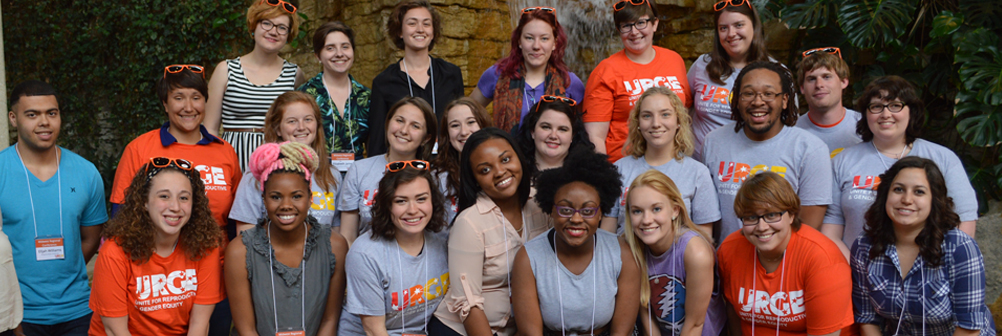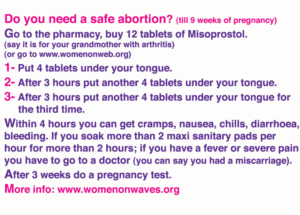Preparing to Live in a World Without Roe: What You Need to Know About Self-Managed Abortions

Posted by Reilly Wieland
September 25, 2018
It is hard for my generation to picture a world before Roe. Even as we have faced draconian laws restricting access and watched clinics close, we hold in the back of our minds that if we were to need it, Roe would protect our access to abortion. We have never known a time when abortion was, legally speaking, entirely out of the question. With that, the image of the back-alley abortion feels far away. The coat hanger feels like an image of the past– one that we won’t return to, and that isn’t a reality anymore. Maybe we know people who have received abortions in this way, but we certainly do not know this reality in the same type of living color that past generations do. Of course, every community feels this differently, but even so, while Roe’s safety net can seem unbreakable to us, it also feels increasingly tenuous. It’s hard to put my finger on, but I think we keep Roe in the back of our minds as a reminder that even when obtaining abortion care appears all but inaccessible, there is still precedent that will protect us.
Maybe this is short-sighted of me. I have spent many years in the reproductive justice movement and know the visceral reality of Roe being overturned. I have seen what it means to live under HB2 in Texas, and I know that it is not far off from what could happen if the Supreme Court’s stars were to align in some kind of anti-choice nightmare. While it benefits all of us to be positive and proactive in resisting Roe’s dissolution, we must also consider that our efforts might not be enough. We can yell and scream all we want, but there is a chance that this will happen anyway.
That is why it’s time for us to create a plan of action if, maybe even when, Roe is overturned. And with that, it’s time for our movement to prepare for a potential wave of self-induced abortions.
It is clear to all of us in the reproductive justice movement that women will die if abortion is illegal or stripped to its most inaccessible forms. In the case that we cannot prevent all of these atrocities in a society without the protection of Roe, we must actively work to keep people seeking abortions safe. And one way we can do that is through assuring we have the knowledge and access to information on self-induced abortions.
We know that self-managed abortions are safe when the knowledge is correctly taught and imparted. In a large-scale study of women who self-managed medical abortions with the help of feminist collective, Women on Web, it is clear that abortion care can still be safe even outside of a doctor’s office. The pills used for a medical abortion, mifepristone and misoprostol, can be successfully administered from home with a success rate of up to 98%. If we can share this knowledge of the administering of these drugs, we can make sure that people stay as safe as possible in a world where they cannot access regulated abortion care from a clinic.
Though self-managed abortion is illegal in many places throughout the United States, groups like Plan C, Women on Waves, and safe2choose provide information and what are essentially how-to guides to self-administering the pills if you are able to obtain them. These groups exist to combat the wave of restrictions, ranging from denying access to mifepristone and misoprostol, banning doctors and pharmacists from administering the needed medication and criminalizing folks who attempt self-managed abortion.
As dire as this all seems, these organization’s are doing the work that must be done right now. To recall the age of the Jane Collective, those of us who have never lived without Roe cannot just simply trust that it is legal precedent. It is time for us to be proactive in spreading information on reproductive care, and with that, be open to sharing these resources with all who might need them or know somebody who would need them (which is everybody). If we are to make sweeping statements about sisterhood being powerful, I think we must support people who seek this care actively in whatever way they can.
The complement to helping spread the word on the reality of self managed abortion is destigmatizing their reality. We must not be fearful of the idea of a self-managed abortion. This is quite possibly our reality, and this movement must refuse to return to the days of stigma. Not only have self-managed abortions been proven to be a safe alternative to an in-clinic procedure, we might not have a choice on the matter either way.
The larger argument to be gleaned from this is that we must return our feminist practice to include this type of one-woman-to-another anecdotal advice. And we must do it now. There is a (somewhat likely) chance that we will live in a society where Roe is all but decimated, and we cannot wait for that day to share this advice. Our job as feminists at this moment is to utilize networks of feminist support openly and honestly.
Leave a Reply
You must be logged in to post a comment.


